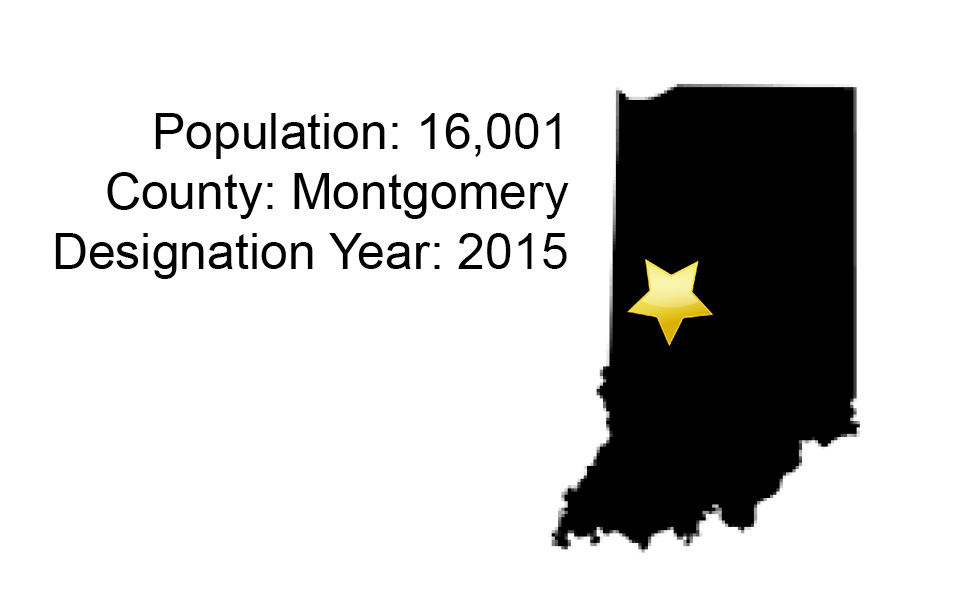Stellar Plan
STELLAR PROJECTS:
- Fusion 54
- Pike Street Pocket Park
- Big Four Trail
- Historic Whitlock Neighborhood Owner-Occupied Rehabilitation
- Downtown Loop Trail
- Ben-Hur Building Adaptive Reuse
BACKGROUND
Like several other designees, Crawfordsville wasn’t able to win their Stellar accreditation on their first attempt. However, through their experience, they learned the importance of remaining flexible in the planning process as well as focused on Crawfordsville’s youth. Previous to this designation, Crawfordsville was struggling to maintain the younger population as well as attract individuals to their downtown. Large, local employers were unable to fill vacant positions and couldn’t attract workers who were willing to work long-term. After being named a finalist in 2012, and applying in 2013 and 2014, they were named a Stellar Designee in 2015.
CRAWFORDSVILLE’S PERSPECTIVE
Crawfordsville’s first encountered the Stellar program when Greencastle, their neighboring community, was named as a designated community in 2011. Inspired by how a similarly sized, rural community could achieve this accomplishment, they began taking steps that would allow them to be in a similar position.
To address the issues they’d identified in the community, Crawfordsville focused on bolstering their economic vitality. Previous to Stellar, Montomery County had completed a Comprehensive Economic Development Plan. Additionally, they installed their first accredited Main Street organization.
“Stellar is a great process because it forces you to develop a good plan that you can implement whether or not you win,” Todd Barton, Mayor of Crawfordsville said. Crawfordsville applied for Stellar four times. However, their absence of a designation did not keep them from making forward motion. Brandy Allen, Crawfordsville’s planning director, used the Stellar funded SIP in the projects that Crawfordsville chose to take on.
“It’s (the SIP) the basis of all of our projects and all of them have moved ahead,” Allen said. However, in order to get to this point, Barton said that they had to refine the vision and better listen to the community. Before the 2015 application, Crawfordsville’s application content was primarily composed by the consulting firm that they hired. Looking back over the non-designated applications, the Stellar committee realized that their applications weren’t truly capturing the essence of what made their community unique. They lost the community’s voice in their application.
“We learned from other finalist’s LOI’s. We didn’t copy them, we just realized that we had to write it for ourselves so that we could capture our passion,” Barton said. After years of applying and planning, Crawfordsville had several projects they were excited to implement. Unfortunately, early in the Stellar process, they realized one of their larger projects would not qualify for state funding. Yet again, they maintained the resilience that three years of denied applications had instilled, and focused on modifying their original plan.
“Don’t hold your plan as an absolute. When you get into the process, you have to be flexible,” Barton said. “Carrying out the specifics and detail are not easy. Once you get down in the weeds, you find things in your plan that won’t get approved.”
Fortunately, the plan’s issues were identified early. To replace the major project that was ineligible for funding, two smaller projects are currently planned to replace it. When it comes to the decision making process surrounding planning, Crawfordsville’s Stellar Advisory Committee spearheads the conversations. However, this group discusses more than just Stellar, they participate in community projects as well. The committee is composed of a broad network of invested organizations within the community.
“It’s (Stellar) provided an opportunity for networking/collaboration in our community that will continue beyond Stellar,” Allen said. Since the community began talking about Stellar, Allen said she’s noticed an increased interest in the community in additional initiatives. Recently, a local resident just completed the fundraising and installation of a clock tower that was installed on their courthouse. Because Stellar has state standards and processes that have to be met, residents are considering getting involved in other, supplementary projects. “When I talk about Stellar, I always let people know that the reality of Stellar is that there are rules,” Barton said. “The challenge is balancing creativity and these rules.”
Barton has also been challenged to ensure that the younger generation’s voice is being included in the planning process. Realistically, in a community that needs more people to settle down and work locally, Barton said that the younger generation has to be a focus. “We don’t really hear from young people, the older generation is more vocal, but you have to keep both of their needs in mind. Quality of life is a very dynamic thing and both generations have very different needs,” Barton said. “You have to think about that next generation and how you’re going to retain them by becoming the place that they want to live in.
”Although many projects are still in the planning phase, Allen believes that the community has already experienced a transformation. “The community looks physically different obviously, but even the fabric of the community has changed,” Allen said. “There’s been such a development in community collaboration and Stellar has given us an opportunity to spotlight and strengthen that.”
Read the one-pager and Strategic Improvement Plan. Visit their website for more information.
